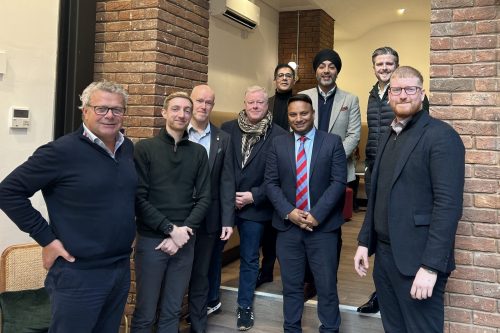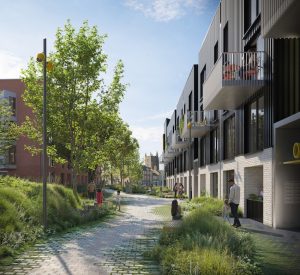Round table report: sustainable development is essential – but expensive


For Ian Burns, director of Cameron Homes, this year and next year are all about “trading through the decrease in volumes and value”.
He said: “We need to recognise that we’re adjusting to a new cost of living and cost of borrowing.
“We’ve got really strong underlying demand and all the metrics for that demand are good: an acute housing shortage, good employment and mortgage availability. Our housing stock is substandard in terms of the amount of it and the quality of it compared to most of Europe. We now have probably the most diverse housing market that I can recall too.
“Next year I think we’ll see some stability in terms of build costs. If we don’t, there’ll be some real issues because we’ve been able to recover a lot of those costly pieces through rising sales values. And until this year, the sales values were beating cost inflation. This year, that’s reversed a little bit”.
Memories of the 2008 financial crisis were brought back for several of the panel, with Paul Squires, CEO of Sama Investments recollecting its diversification into PBSA development.
“Back in the recession, we were 100% residential. We were best friends with banks on one day and the next they wanted their money back – it was a huge amount of stress, so we moved into PBSA.
“The problem now fundamentally, is resources for the local authorities. You have your planning officer that you deal with, but then the people behind them who are providing the various reports on the heritage or the drainage etc – rely on the small volume of people to do the work. You don’t have people of a certain quality to do the work. Everyone could be working so hard but they can’t get it to move it forward.
“We’re getting caught on every single side of the coin on making the scheme viable. The councils are under pressure from a labour point but we’re experiencing two years worth of planning to get a ticket and not build out.
“That’s why we’re seeing a lack of development in Digbeth when there’s all of these viability issues”.

“But what I’ve asked Andy Street is, how can these young people looking to come into the sector know there’s a job waiting for them? Especially if the planning system does not change.
“I’ve had five sites rejected and planners won’t say why and when you submit the pre-app – they always just sit on the fence. It’s silly things which are slowing down the pipeline and meaning Birmingham misses out on much-needed housing”.
Trussenomics rocked the market last year resulting in instability and lack of confidence. Anna Cooper, assistant editor of TheBusinessDesk in the West Midlands asked the panel if any confidence had been restored.
For Satwant Bhandal, corporate relationship director at Crystal Specialist Finance, the short answer is “no”.
He said: “Taking the example of planning – if that takes longer, it kicks everything along. If you no longer acquire land with the confidence that you’re going to be able to get planning, then lenders are chasing you for that deadline.
“The developer is under pressure and alongside that, you’ve got the development lender thinking, we’ve got 100 million here, we’re not really sure we want to lend this, but we might give the impression that we do.
“As a broker, we approach those lenders and they say we’ll give you X, but when you finally get planning we might not give it to you because our confidence has shifted.
“Literally every single lender in the market dropped their deals after Trussenomics until they had surety of what was going to happen that week. Some of the largest bridging lenders just said well, we will promise you what we promised till the end of this week. Next week those deals are dead”.
Cameron Linnell, relationship manager at Avamore Capital, does, however, feel more positive after lenders’ pipelines were decimated.
“If you look at where we are now, versus the position we were in this time last year, we’re starting the year standing. We’re back to the key principles of lending where it’s very easy to get money out of the door.
“I can lend out £5m but getting it back is a different story. The challenges that developers are facing are what lenders need to consider too. The easy bit is getting it out, the challenge is a developer being stuck in a deal and the market shifts and build costs rise – that’s a very difficult position for all parties”.
The Harrogate Group’s CEO Faisal Arif echoed these thoughts saying, “It is easy to get money out the door, but now we spend much more time on focusing on the deal and the exit and really nailing it.
“It’s a cyclical market – it will come back and will drop off, but I think where we are now has meant everything comes with a challenge.
“We do need change. We need to effectively have a pricing correction to help the cost of living. Next year will probably plateau and then drop a little bit, but I think the cost of materials and construction will pretty much remain the same”.
Mark Davidson, head of loan management for CrowdProperty felt “there’s a difference now from the traditional banks where you used to get your development finance from, to the secondary funders that can be more flexible.
“There’s been a pattern now over the last 12/18 months with trading supplies which has been extremely difficult. We know that as funders, that costs have gone up probably 20-25% and you’ve probably lost a lot of your labour force.
“I was a fan of PBSA development, but it’s all about time. If you miss going to market before the end of the academic year you’ve got a bit of a problem. You’ve also got overseas students – how much percentage have you got on that? That is a heavy reliance for PBSA.
“You could look at the Liverpool model which is my favourite when I’m talking to developers. The big problem with Liverpool is that they didn’t put a moratorium on it. So you’ve got current stock, brand new, old stock, stock that’s half-built, and you’ve got stock in the pipeline. It’s an oversupply”.
A new kind of smaller developer has entered the market believes Adam Butler, head of sales for Avamore Capital – one that is doing it for the first time.
The less experienced developer is also being more cautious in instructing its solicitors, QS and development surveyor.
Butler said, “Because of constraints like GDP, uncertainty and land prices, gone are the days of instructing your development surveyors etc at the same time because you’re waiting to see if the deal is coming in first and then you’ll look at building.
“I’ve seen this more in the less experienced in the market, but the more experienced are confident in their numbers but are seeing an increase in competition for sites”.
This was felt by Ian Burns when tendering for sites.
For a typical Cameron Homes site of five acres for £5m, Burns would expect to see nine to twelve bidders, with two or three very keen.

“An example of this I heard just yesterday and I couldn’t quite believe it. An edge-of-town rugby club wants to improve their car park and an energy company approached them for 1.8 acres and offered them £90k a year on a 30-year lease”.
With the next phase of the Future Homes Standard planned to come into force in 2025, sustainable development is high on the agenda – but it comes at a cost.
Jonathan Driver, property development finance manager at Aldermore, says “It’s great to be working with developers who are championing those causes and looking for like the homes the next generations.
“The reality is that you’ve got the extra cost associated with getting those homes to those standards. On the one hand, you can consider you selling that property for X % more to recoup that.
“You can also consider whether to go for EPC A or B and some lenders are offering incentives for energy efficiency. You might save £20k on your exit fee, but does it actually cost you £50k more to put air source heat pumps and solar panels on the development?”
Zahir Ahmed believes it is “a balancing act.
“There’s an exit fee and they take off half a per cent. Spending £35k – £50k on solar panels and air source heat pumps – is it worth it?
“The house is going to sell if it’s EPC B rated and there are already complications in trying to make sure there’s not too much glass for heating and the building regs cost more than what they were before. Cavity walls are bigger so there’s more insulation in to keep homes warm.
“I think people more look at heat source pumps and solar panels once they actually spent money on the house and have lived in it”.
A big debate in the Sama Investments office is the ethical approach to being sustainable and making a profit.
“We’re living in a very exciting time with all the new technology coming in and we’re looking at all the things that would need to be incorporated in a home in 50 years time,” said Squire.
“It currently isn’t cost-effective to be sustainable because of the price of materials. So how do you ensure that scheme is built forward? The only way is to increase the price per square foot on the sale value or rent – because there’s no other way”.
Whilst some argued that being sustainable is currently a trend, Burns believes that “people can’t afford to be as sustainable as they want to be”.
He said: “A lot of people want to reduce their carbon footprint, it is trendy, but I think it’s going beyond a trend and people are interested in COP28 and obviously don’t want the planet to be destroyed.
“From our perspective, capital cost is definitely high. There are some people who can afford to pay for that benefit. Most people want to know what the benefit to them is and it’s low energy bills”.









